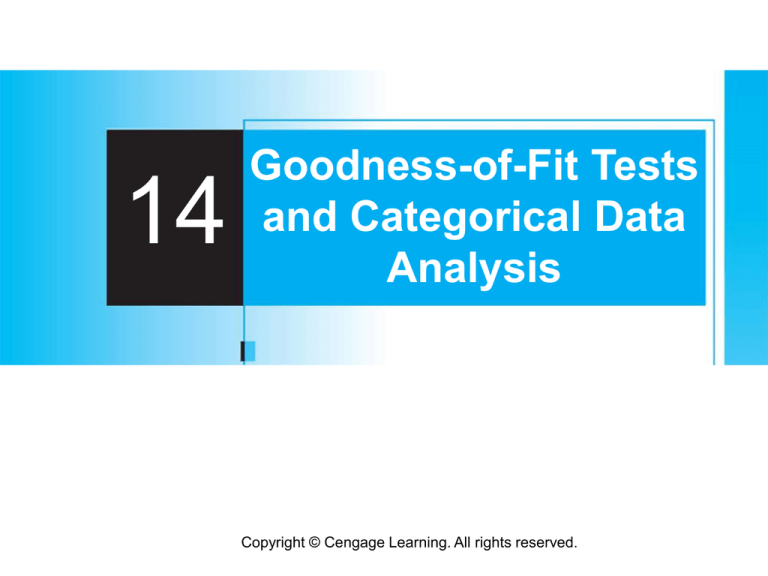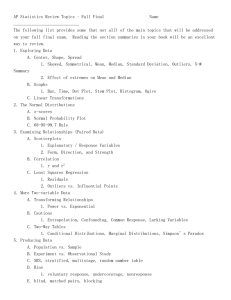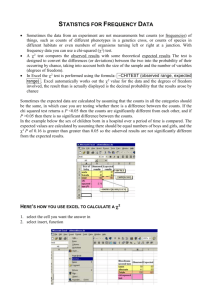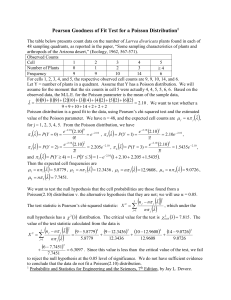
14
Goodness-of-Fit Tests
and Categorical Data
Analysis
Copyright © Cengage Learning. All rights reserved.
14.2
Goodness-of-Fit Tests for
Composite Hypotheses
Copyright © Cengage Learning. All rights reserved.
Goodness-of-Fit Tests for Composite Hypotheses
We presented a goodness-of-fit test based on a χ2 statistic
for deciding between H0: p1 = p10, . . . , pk = pk0 and the
alternative Ha stating that H0 is not true.
The null hypothesis was a simple hypothesis in the sense
that each pi0 was a specified number, so that the expected
cell counts when H0 was true were uniquely determined
numbers.
3
Goodness-of-Fit Tests for Composite Hypotheses
In many situations, there are k naturally occurring
categories, but H0 states only that the pi’s are functions of
other parameters 1, . . . , m without specifying the values
of these ’s.
For example, a population may be in equilibrium with
respect to proportions of the three genotypes AA, Aa, and
aa. With p1, p2, and p3 denoting these proportions
(probabilities), one may wish to test
H0: p1 = 2, p2 = 2(1 – ), p3 = (1 – )2
where represents the proportion of gene A in the
population.
(14.1)
4
Goodness-of-Fit Tests for Composite Hypotheses
This hypothesis is composite because knowing that H0 is
true does not uniquely determine the cell probabilities and
expected cell counts but only their general form.
To carry out a χ2 test, the unknown i’s must first be
estimated.
Similarly, we may be interested in testing to see whether a
sample came from a particular family of distributions
without specifying any particular member of the family.
5
Goodness-of-Fit Tests for Composite Hypotheses
To use the χ2 test to see whether the distribution is Poisson,
for example, the parameter must be estimated.
In addition, because there are actually an infinite number of
possible values of a Poisson variable, these values must
be grouped so that there are a finite number of cells.
If H0 states that the underlying distribution is normal, use of
a χ2 test must be preceded by a choice of cells and
estimation of and .
6
χ2 When Parameters Are
Estimated
7
χ2 When Parameters Are Estimated
As before, k will denote the number of categories or cells,
and pi will denote the probability of an observation falling in
the ith cell.
The null hypothesis now states that each pi is a function of
a small number of parameters 1, . . . , m with the i’s
otherwise unspecified:
H0: p1 = 1(), . . . , pk = k()
Ha: the hypothesis H0 is not true
where = (1, . . . , m)
(14.2)
8
χ2 When Parameters Are Estimated
For example, for H0 of (14.1), m = 1 (there is only one ),
1() = 2, 2() = 2(1 – ), and 3() = (1 – )2.
In the case k = 2, there is really only a single rv, N1
(since N1 + N2 = n), which has a binomial distribution.
The joint probability that N1 = n1 and N2 = n2 is then
P(N1 = n1, N2 = n2) =
where p1 + p2 = 1 and n1 + n2 = n.
9
χ2 When Parameters Are Estimated
For general k, the joint distribution of N1, . . . , Nk is the
multinomial distribution with
P(N1 = n1, . . . , Nk = nk)
(14.3)
When H0 is true, (14.3) becomes
P(N1 = n1, . . . , Nk = nk)
(14.4)
To apply a chi-squared test, = (1, . . . , m) must be
estimated.
10
χ2 When Parameters Are Estimated
Method of Estimation
Let n1, n2, . . . , nk denote the observed values of
N1, . . . , Nk. Then
are those values of the i’s
that maximize (14.4).
The resulting estimators
are the maximum
likelihood estimators of 1, . . . , m.
11
Example 5
In humans there is a blood group, the MN group, that is
composed of individuals having one of the three blood
types M, MN, and N. Type is determined by two alleles, and
there is no dominance, so the three possible genotypes
give rise to three phenotypes.
A population consisting of individuals in the MN group is in
equilibrium if
P(M) = p1 = 2
P(MN) = p2 = 2(1 – )
12
Example 5
cont’d
P(N) = p3 = (1 – )2
for some .
Suppose a sample from such a population yielded the
results shown in Table 14.4.
Observed Counts for Example 14.5
Table 14.4
13
Example 5
cont’d
Then
Maximizing this with respect to (or, equivalently,
maximizing the natural logarithm of this quantity, which is
easier to differentiate) yields
With n1 = 125 and n2 = 225,
= 475/1000 = .475.
14
χ2 When Parameters Are Estimated
Once = (1, . . . , m) has been estimated by
, the estimated expected cell counts are
the ni( )s.
15
χ2 When Parameters Are Estimated
Theorem
Under general “regularity” conditions on 1, . . . , m and the
i()s, if 1, . . . , m are estimated by the method of
maximum likelihood as described previously and n is large,
has approximately a chi-squared distribution with
k – 1 – m df when H0 of (14.2) is true.
16
χ2 When Parameters Are Estimated
An approximately level test of H0 versus Ha is then to
reject H0 if
. In practice, the test can be used
if ni( ) 5 for every i.
Notice that the number of degrees of freedom is reduced
by the number of i’s estimated.
17
Example 6
(Example 5 continued…)
With = .475 and n = 500, the estimated expected cell
counts are
n1( ) = 500 ( )2 = 112.81,
n2( ) = (500)(2)(.475)(1 .475) = 249.38, and
n3( ) = 500 112.81 249.38 = 137.81. Then
χ2 =
= 4.78
18
χ2 When Parameters Are Estimated
Since
and 4.78 3.843,
H0 is rejected. Appendix Table A.11 shows that
P - value .029.
One of the conditions on the i’s in the theorem is that they
be functionally independent of one another.
That is, no single i can be determined from the values of
other i’s, so that m is the number of functionally
independent parameters estimated.
19
χ2 When Parameters Are Estimated
A general rule of thumb for degrees of freedom in a
chi-squared test is the following.
20
Goodness of Fit for Discrete
Distributions
21
Goodness of Fit for Discrete Distributions
Many experiments involve observing a random sample
X1, X2, . . . , Xn from some discrete distribution. One may
then wish to investigate whether the underlying distribution
is a member of a particular family, such as the Poisson or
negative binomial family.
In the case of both a Poisson and a negative binomial
distribution, the set of possible values is infinite, so the
values must be grouped into k subsets before a
chi-squared test can be used.
22
Goodness of Fit for Discrete Distributions
The groupings should be done so that the expected
frequency in each cell (group) is at least 5. The last cell will
then correspond to X values of c, c + 1, c + 2, . . . for some
value c.
This grouping can considerably complicate the computation
of the
and estimated expected cell counts. This is
because the theorem requires that the
be obtained from
the cell counts N1, . . . , Nk rather than the sample values
X1, . . . , Xn.
23
Example 8
Table 14.7 presents count data on the number of Larrea
divaricata plants found in each of 48 sampling quadrats, as
reported in the article “Some Sampling Characteristics of
Plants and Arthropods of the Arizona Desert” (Ecology,
1962: 567–571).
Observed Counts for Example 8
Table 14.7
24
Example 8
cont’d
The article’s author fit a Poisson distribution to the data.
Let denote the Poisson parameter and suppose for the
moment that the six counts in cell 5 were actually 4, 4, 5, 5,
6, 6.
Then denoting sample values by x1, . . . , x48, nine of the
xi’s were 0, nine were 1, and so on.
The likelihood of the observed sample is
25
Example 8
cont’d
The value of for which this is maximized is
= xi /n = 101/48 = 2.10 (the value reported in the article).
However, the required for χ2 is obtained by maximizing
Expression (14.4) rather than the likelihood of the full
sample.
The cell probabilities are
26
Example 8
cont’d
so the right-hand side of (14.4) becomes
There is no nice formula for , the maximizing value of ,
in this latter expression, so it must be obtained numerically.
27
Goodness of Fit for Discrete Distributions
Because the parameter estimates are usually more difficult
to compute from the grouped data than from the full
sample, they are typically computed using this latter
method.
When these “full” estimators are used in the chi-squared
statistic, the distribution of the statistic is altered and a level
test is no longer specified by the critical value
.
28
Goodness of Fit for Discrete Distributions
Theorem
Let
be the maximum likelihood estimators of
1, . . . , m based on the full sample X1, . . . , Xn, and let χ2
denote the statistic based on these estimators. Then the
critical value c that specifies a level upper-tailed test
satisfies
(14.7)
29
Goodness of Fit for Discrete Distributions
The test procedure implied by this theorem is the following:
If χ2
If χ2
If
, reject H0.
, do not reject H0.
< χ2 <
(14.8)
, withhold judgement.
30
Example 9
Example 8 continued…
Using = 2.10, the estimated expected cell counts are
computed from ni( ), where n = 48.
For example,
n1( ) = 48
= (48)(e–2.1)
= 5.88
31
Example 9
cont’d
Similarly,
n2( ) = 12.34,
n3( ) = 12.96,
n4( ) = 9.07, and
n5() = 48 – 5.88 – · · · – 9.07 = 7.75.
Then
32
Example 9
Since m = 1 and k = 5, at level .05 we need
and
= 9.488.
cont’d
= 7.815
Because 6.31 7.815, we do not reject H0; at the 5% level,
the Poisson distribution provides a reasonable fit to the
data.
Notice that
= 6.251 and
= 7.779, so at level .10
we would have to withhold judgment on whether the
Poisson distribution was appropriate.
33
Goodness of Fit for Continuous
Distributions
34
Goodness of Fit for Continuous Distributions
The chi-squared test can also be used to test whether the
sample comes from a specified family of continuous
distributions, such as the exponential family or the normal
family.
The choice of cells (class intervals) is even more arbitrary
in the continuous case than in the discrete case.
To ensure that the chi-squared test is valid, the cells should
be chosen independently of the sample observations.
35
Goodness of Fit for Continuous Distributions
Once the cells are chosen, it is almost always quite difficult
to estimate unspecified parameters (such as and in the
normal case) from the observed cell counts, so instead
mle’s based on the full sample are computed.
The critical value c again satisfies (14.7), and the test
procedure is given by (14.8).
36
Example 10
The Institute of Nutrition of Central America and Panama
(INCAP) has carried out extensive dietary studies and
research projects in Central America.
In one study reported in the November 1964 issue of the
American Journal of Clinical Nutrition (“The Blood Viscosity
of Various Socioeconomic Groups in Guatemala”), serum
total cholesterol measurements for a sample of 49
low-income rural Indians were reported as follows (in
mg/L):
37
Example 10
cont’d
Is it plausible that serum cholesterol level is normally
distributed for this population?
Suppose that prior to sampling it was believed that
plausible values for and were 150 and 30, respectively.
The seven equiprobable class intervals for the standard
normal distribution are (– , –1.07), (–1.07, –.57),
(–.57, –.18), (–.18, .18), (.18, .57), (.57, 1.07), and
(1.07, ), with each endpoint also giving the distance in
standard deviations from the mean for any other normal
distribution.
38
Example 10
cont’d
For = 150 and = 30, these intervals become
(– , 117.9), (117.9, 132.9), (132.9, 144.6), (144.6, 155.4),
(155.4, 167.1), (167.1, 182.1), and (182.1, ).
To obtain the estimated cell probabilities
1( , ), . . . , 7( , ), we first need the mle’s
and
.
Earlier we seen, the mle of was [(xi – x)2/n]1/2 (rather
than s), so with s = 31.75,
= x = 157.02
39
Example 10
cont’d
Each i( , ) is then the probability that a normal rv X with
mean 157.02 and standard deviation 31.42 falls in the ith
class interval. For example,
2( , ) = P(117.9 X 132.9) = P(–1.25 Z –.77)
= .1150
so n2( , ) = 49(.1150) = 5.64.
40
Example 10
cont’d
Observed and estimated expected cell counts are shown in
Table 14.8.
Observed and Expected Counts for Example 10
Table 14.8
41
Example 10
cont’d
The computed χ2 is 4.60. With k = 7 cells and m = 2
parameters estimated,
and
.
Since 4.60 9.488, a normal distribution provides quite a
good fit to the data.
42
A Special Test for Normality
43
A Special Test for Normality
As we know that the probability plots are an informal
method for assessing the plausibility of any specified
population distribution as the one from which the given
sample was selected.
The straighter the probability plot, the more plausible is the
distribution on which the plot is based. A normal probability
plot is used for checking whether any member of the
normal distribution family is plausible.
Let’s denote the sample xi’s when ordered from smallest to
largest by
44
A Special Test for Normality
Then the plot suggested for checking normality was a plot
of the points (x(i), yi), where
yi = Φ–1((i – .5)/n).
A quantitative measure of the extent to which points cluster
about a straight line is the sample correlation coefficient r.
Consider calculating r for the n pairs
(x(1), y1), . . . , (x(n), yn). The yi’s here are not observed
values in a random sample from a y population, so
properties of this r are quite different from those described
earlier.
45
A Special Test for Normality
However, it is true that the more r deviates from 1, the less
the probability plot resembles a straight line (remember that
a probability plot must slope upward).
This idea can be extended to yield a formal test procedure:
Reject the hypothesis of population normality if r c,
where c is a critical value chosen to yield the desired
significance level .
That is, the critical value is chosen so that when the
population distribution is actually normal, the probability of
obtaining an r value that is at most c(and thus incorrectly
rejecting H0) is the desired .
46
A Special Test for Normality
The developers of the Minitab statistical computer package
give critical values for = .10, .05, and .01 in combination
with different sample sizes.
These critical values are based on a slightly different
definition of the yi’s than that given previously. Minitab will
also construct a normal probability plot based on these yi’s.
The plot will be almost identical in appearance to that
based on the previous yi’s. When there are several tied
x(i)’s, Minitab computes r by using the average of the
corresponding yi’s as the second number in each pair.
47
A Special Test for Normality
Let yi = Φ–1[(i – .375)/(n + .25)] , and compute the sample
correlation coefficient r for the n pairs
(x(1), y1), . . . , (x(n), yn). The Ryan-Joiner test of
H0: the population distribution is normal
versus
Ha: the population distribution is not normal
consists of rejecting H0 when r c. Critical values c are
given in Appendix Table A.12 for various significance levels
and sample sizes n.
48
Example 12
The following sample of n = 20 observations on dielectric
breakdown voltage of a piece of epoxy resin.
49
Example 12
cont’d
We asked Minitab to carry out the Ryan-Joiner test, and the
result appears in Figure 14.3.
Minitab output from the Ryan-Joiner test for the data of Example 12
Figure 14.3
50
Example 12
cont’d
The test statistic value is r = .9881, and Appendix Table
A.12 gives .9600 as the critical value that captures
lower-tail area .10 under the r sampling distribution curve
when n = 20 and the underlying distribution is actually
normal.
Since .9881 > .9600, the null hypothesis of normality
cannot be rejected even for a significance level as large as
.10.
51







